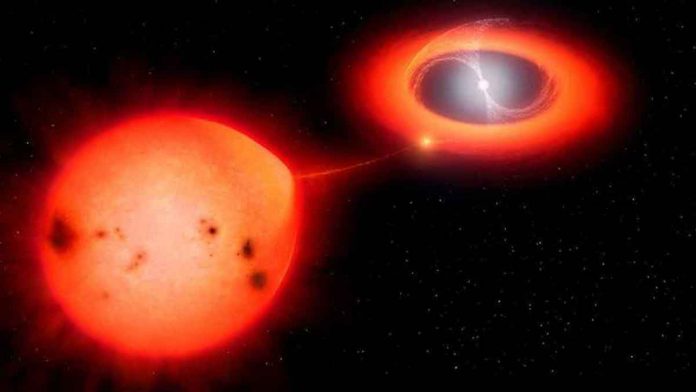Astronomers worldwide are abuzz with excitement as they bear witness to a celestial spectacle like no other.
A fleeting burst of brilliance, known as a nova, has captured the attention of scientists, drawing them into the enigmatic depths of an even more peculiar star.
This extraordinary event offers the potential to unravel not only the mysteries surrounding novae but also the broader secrets of our solar system’s chemistry, the demise of stars, and the evolution of the universe itself.
A nova, a dazzling explosion of light, is born from the interplay of a white dwarf and a neighboring companion star within a two-star system.
Over time, the white dwarf siphons matter from its companion, which accumulates on its surface.
This matter becomes superheated and ultimately triggers an uncontrollable reaction, releasing an explosive burst of energy visible to us as radiant light.
Revelations for Our Solar System and Beyond:
Novae play a crucial role in the cosmic cycle of matter in space. As a white dwarf collects and modifies matter during a nova explosion, it enriches the surrounding space with new elements.
These ejected materials eventually coalesce to form new stellar systems, playing a vital part in the formation of celestial bodies, including our own solar system.
Astonishingly, this latest nova discovery has implications for Earth’s history.
Studying these cosmic explosions has enabled scientists to ascertain that novae produced a significant amount of lithium, one of the essential chemical elements on our planet.
The Unpredictable Road to Supernova:
Furthermore, the nova’s rapid cycle of collecting matter during eruptions, combined with not expelling all the collected material, leads to an increase in mass with each cycle.
This mounting instability could ultimately trigger the white dwarf’s explosion into a type 1a supernova—one of the brightest and most uniform events known to astrophysicists.
These supernovae serve as standard candles, providing invaluable tools for measuring distances and understanding the universe’s three-dimensional structure.
Living Laboratories of Stellar Evolution:
Novae also offer a unique opportunity to explore the enigmatic deaths of stars within binary systems, a process not yet fully comprehended.
They serve as living laboratories for scientists to observe nuclear physics in action and test theoretical concepts.
The Pulsating Mystery:
As scientists delved deeper into V1674 Hercules, they discovered a series of baffling phenomena.
The nova emitted not only light and energy but also peculiar pulsations akin to the echoes of a resonating bell.
These pulsations occurred in both visible light waves and X-rays at an astonishing frequency of every 501 seconds.
Remarkably, this pulsating behavior persisted for over a year after the initial explosion, possibly even longer.
The mystery deepens as scientists ponder the driving force behind this rhythmic oscillation, evident even before the outburst when the nova shone ten magnitudes brighter.
Unraveling this enigmatic pulsation could lead to groundbreaking insights into the mechanisms governing these celestial events.
Winds of Change: Shaping Space and Time
Intriguingly, researchers monitoring the matter ejected by the nova’s explosion detected a peculiar influence—a mysterious wind shaping the flow of material in the space surrounding the system.
The emergence of this wind seemed dependent on the positions of both the white dwarf and its companion star.
Understanding this intricate interplay could offer unprecedented glimpses into the dynamic forces shaping celestial bodies.
A Stellar Surprise, Discovered by Chance:
In an unexpected turn of events, the discovery of the fastest nova was made by Seidji Ueda, a Japanese amateur astronomer.
This highlights the invaluable contributions of citizen scientists and modern technology to the field of astronomy.
Though the nova has faded beyond the range of most telescopes, the Large Binocular Telescope, with its cutting-edge equipment, including the PEPSI high-resolution spectrograph, continues to monitor this cosmic wonder.
The Journey to Unravel the Cosmic Riddles:
The team of astronomers intends to delve further into the cause of the nova’s outburst, the forces shaping its surroundings, and the pulsating rhythm that remains shrouded in mystery.
This quest for understanding may lead to groundbreaking insights into the very fabric of our universe and its most spectacular phenomena.
As the world’s eyes turn to the heavens, the allure of the cosmos continues to captivate, drawing us into the depths of the unknown and leaving us with a profound appreciation for the wonders of the universe.

